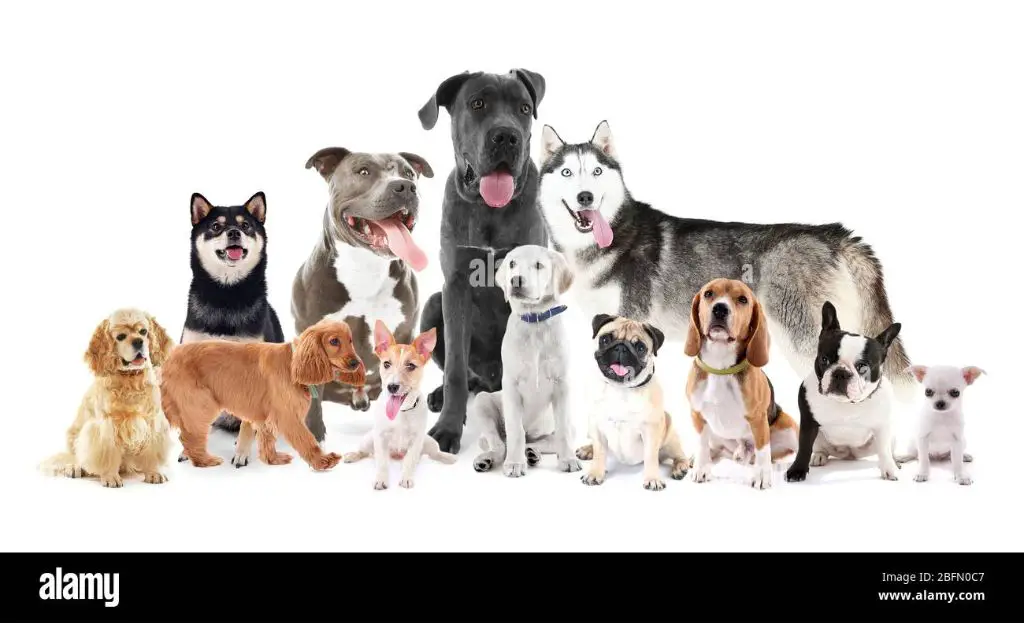Introduction
Dog breeds have existed for thousands of years, and today there are over 300 recognized breeds worldwide. These breeds reflect differences in geography and climate, history, culture, and breeding practices. Studying the distribution, origin, and traits of dog breeds can provide insight into humankind’s relationship with dogs over time and around the globe. Certain countries like the United Kingdom, France, and Germany stand out for having produced dozens of well-known breeds while in others far fewer breeds emerged. Exploring which countries have the greatest diversity of dog breeds is an interesting lens for understanding how dogs became so varied and specialized based on location and purpose.
Countries With the Most Dog Breeds

When it comes to the number of dog breeds originating within their borders, certain countries stand out as the top producers of canine diversity. According to the World Population Review, the top countries with the most native dog breeds are:
1. United Kingdom – 76 breeds
2. France – 71 breeds
3. Germany – 47 breeds
4. United States – 41 breeds
5. Russia – 27 breeds
6. Japan – 21 breeds
7. China – 20 breeds
8. Italy – 19 breeds
9. Belgium – 16 breeds
10. Australia/Canada – 14 breeds
The large number of breeds originating from European nations like the UK, France and Germany reflects these countries’ long history of breeding dogs for various jobs and roles. For example, France produced breeds like the poodle and French bulldog, while Germany is known for shepherds, hounds and schnauzers. The US and Russia have also contributed significantly to global canine diversity.
Overall, Europe dominates as the region with the most dog breeds due to its centuries-old aristocratic tradition of breeding dogs for appearances, jobs and sports like hunting. The top 10 countries alone account for over 300 distinct dog breeds, highlighting canine diversity.
History of Dog Breeding
Dog breeding began thousands of years ago, with the earliest evidence of dog domestication dating back approximately 14,000 years [1]. Some of the earliest dog breeds emerged in ancient civilizations, with unique breeds developing in regions like Egypt, Greece, China, and Rome [2].
In Europe during the Middle Ages, systematic dog breeding began to take shape, as people started breeding dogs for specific jobs like hunting, herding, and guarding. This marked the origins of many of the hunting and working dog breeds we know today [3]. During the Victorian era, dog breeding became a popular hobby, marking the start of breeding dogs for appearance and creating some toy and companion breeds.
As Europeans began exploring and colonizing other parts of the world in the 17th-19th centuries, they brought their dogs with them, influencing the development of local breeds in places like North America, Australia, and Africa. Today, while the practice remains controversial, dog breeding continues to evolve around the world.
Most Popular Dog Breeds
The United States, France, and the United Kingdom have among the highest numbers of registered dog breeds according to the American Kennel Club and other registries. Some of the most popular breeds in these countries include:

- Labrador Retriever – Originally from Canada and known for being friendly, active, and intelligent. It has been the most popular breed in the US for over 20 years.
- French Bulldog – A smaller breed from England that became popular as city pets in France in the 1800s. They have a stocky build and sociable personality.
- Golden Retriever – Developed as gundogs in Scotland in the mid-19th century. Known for being eager to please and gaining popularity as family pets.
- German Shepherd – Originated as herding dogs in Germany and noted for being intelligent and loyal. Used nowadays as police, military, and service dogs.
- Poodle – Bred as water retrievers in Germany but became popular companion dogs in France. Come in three sizes and known for being highly intelligent.
Other popular breeds in the top dog-owning countries include Bulldogs, Beagles, Rottweilers, and Cocker Spaniels. The popularity of certain breeds often relates to their history and purpose in those countries.
Influence of Climate and Geography
The types of dogs bred in different parts of the world have been heavily influenced by geographic and climatic factors. For example, in colder northern regions like Siberia,Canada and parts of Northern Europe, breeds like the Siberian Husky[1] and Alaskan Malamute were developed to pull sleds and thrive in frigid weather. Their thick coats and high endurance made them well suited to harsh conditions.

In the mountains of Switzerland, the Saint Bernard was bred as a rescue dog that used its large size and sense of smell to find lost travelers in heavy snowstorms[2]. In the humid Amazon rainforests, local breeds like the short-coated Fila Brasileiro were better adapted to hot and wet terrain. Meanwhile, in the Middle East and Africa, athletic sighthound breeds that could cope with desert heat like the Saluki were developed.
The lifestyle and needs of local populations also shaped dog breeding. Hunting dogs like Labrador Retrievers and Cocker Spaniels were bred in the United Kingdom, while herding dogs like the Welsh Corgi and Shetland Sheepdog arose in pastoral communities. The diversity of modern dog breeds reflects how local conditions and customs influenced selective breeding around the world.
Cultural Significance
Certain dog breeds have become culturally significant symbols and status symbols throughout history. For example, the Pekingese was cherished by Chinese Imperial families and became a symbol of their status and power (https://thedogbreeds.co.uk/the-dogipedia/cultural-significance-of-dog-breeds/). In ancient Egypt, greyhound-type dogs were revered and mummified as they were associated with Anubis, the jackal-headed god of the afterlife. Dogs like Salukis were prized by nomadic tribes in the Middle East for their hunting abilities in the desert (https://en.wikipedia.org/wiki/Cultural_depictions_of_dogs).
In modern times, some breeds have become associated with luxury, glamour and prestige. For instance, breeds like the Chihuahua, Pomeranian and French Bulldog are often treated as “accessory” dogs by celebrities and the wealthy. Certain large guard dog breeds like Dobermans and Rottweilers can symbolize status and intimidation. In many cultures, mixed breed or “mongrel” dogs are looked down upon as symbols of poverty or stray animal populations.
Beyond status, dogs are often bred for specific purposes like herding, hunting, sled-pulling or companionship. Border Collies have been bred for their amazing ability to control sheep. Labrador and Golden Retrievers are prized for retrieving downed birds during hunts. Siberian Huskies and Alaskan Malamutes are optimized for pulling sleds across snow. Breed selection and purpose has been intertwined with human culture and history for millennia.
Breeding Practices
Breeding practices vary significantly by country and region. Some key factors that influence breeding approaches include cultural preferences, climate, geography, regulations, and the priorities of major kennel clubs.
For example, in the UK, the Kennel Club emphasizes health and function in their breeding standards. Breeders must screen for genetic diseases and carefully select pairings to avoid exaggerations that lead to health issues (https://cgejournal.biomedcentral.com/articles/10.1186/s40575-020-00085-9).
In the United States, the American Kennel Club also stresses health, but breed standards are more focused on preserving heritage and purebred lineages. The AKC provides extensive guidelines on responsible breeding practices to promote healthy, well-socialized puppies (https://www.akc.org/breeder-programs/breeder-education/akcs-guide-responsible-dog-breeding/).
Some countries with less established kennel clubs may focus more on appearance than health in breeding selections. Lack of access to modern veterinary care can also impact breeding and disease prevention (https://www.vin.com/apputil/content/defaultadv1.aspx?id=5947812&pid=11387).
Overall, cultural preferences, climate suitability, geographic isolation, and kennel club philosophies all contribute to divergent breeding practices worldwide.
Health and Genetics
Certain dog breeds are predisposed to developing health problems due to their genetic traits and breeding histories. For example, according to the WebMD article, large breeds like Rottweilers are prone to joint problems including hip dysplasia, elbow dysplasia, arthritis, and more. Smaller breeds like pugs and bulldogs often suffer from breathing issues due to their squished facial structures. Retrieved breeds like Labrador Retrievers and Golden Retrievers have very high cancer rates. Other breeds prone to genetic disorders include German Shepherds (hip dysplasia), Beagles (epilepsy), Boxers (heart conditions), and more.
Inbreeding and irresponsible breeding practices have exacerbated many of these breed-specific disorders over time. Reputable breeders aim to screen for and eliminate genetic diseases through careful selection of breeding stock. But back-yard breeders often fail to test or screen their dogs, perpetuating defects generation after generation. Legislation around responsible breeding practices varies widely globally.
Overall, while purebred dogs do tend to have higher incidences of certain genetic conditions, mixed breeds can also inherit disorders. Proper health screening and genetic testing enables owners and breeders to make informed choices for healthier dogs in the future.
Future Outlook

Some experts think there will continue to be new dog breeds developed in the future, though at a slower pace than historically. There is controversy around developing new breeds when many existing breeds face health and genetic challenges (Wilkie, 1999). However, responsible breeders are focused on improving breed standards to promote healthier, structurally sound dogs (Future Dog Breeding for Genetic Soundness).
Many existing breeds suffer from inherited diseases and conditions due to small gene pools and closed breeding populations. Advocates are pushing for outcrossing and new statistical approaches for calculating genetic risk in order to improve breed health (Advancing Genetic Selection and Behavioral Genomics…). Preserving breed traits while enhancing genetic diversity will continue to be a major challenge.
Breed clubs and organizations play an important role in setting standards and educating breeders. As science progresses, best practices for ethical, humane breeding will evolve. The future of dog breeding needs a collaborative, scientific and ethics-focused approach to protect canine health and welfare.
Conclusion
In conclusion, certain countries such as the United Kingdom, France, and Germany have historically been home to the most dog breeds due to their early interest in developing pedigree animals. Key factors that have contributed to high numbers of native breeds in these nations include geography, culture, and breeding practices. While some countries have focused on creating breeds for certain jobs or climates, others have prized dogs more as companions and status symbols.
Today, there are hundreds of recognized dog breeds around the world, though the majority originated in Europe. As we’ve seen, the popularity of breeds has shifted over time and continues to change. Regardless of where they were first established, dogs now live and work worldwide thanks to international kennel clubs, dog shows, and global trade. Going forward, responsible breeding practices and canine genetics research will be crucial to maintaining healthy, happy dogs.
The history and diversity of dog breeds is a fascinating lens through which we can view humanity’s bond with our best friends. Each breed’s origins and purpose provide insight into cultural values, lifestyles, and innovations across eras and regions. Understanding this rich breeding tradition allows us to better appreciate all that dogs have contributed to humankind.